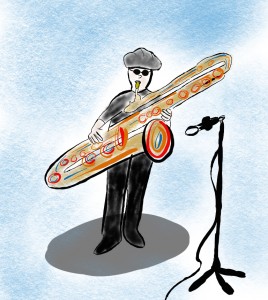 Received two similar questions about the octave key on the saxophone. Leave a comment below with additional questions.
Received two similar questions about the octave key on the saxophone. Leave a comment below with additional questions.
Why do we have to use the register key on some notes?
-Camden
The key at the back of my upper left hand when exactly am I obligated to press it.
-Shedrack
My response:
You can play different notes on the saxophone by effectively changing the size of the saxophone (where the air comes out). If you press all the keys that cover the tone holes, you get a low Bb.
If you want to think about the physics of it all, notes sound from the saxophone because you create standing waves with the air inside the horn (if you don’t want to think about that, don’t worry too much about it!). You cover and uncover different holes in the tube of the saxophone to change the length and properties of the instrument.
The position and size of the hole for the octave key has the effect of raising notes by one octave. That does not mean it is absolutely required to get the sound of the note (you may have experienced playing overtones even on accident), but it does make it easier to get certain notes.
The effect of pressing the octave key is to raise the lower notes by exactly one octave. The notes an octave apart have the same letter names. So playing a G with three fingers on the left hand and then playing the G with three fingers and the octave key means the notes are an octave apart. Physically, an octave above means doubling the frequency of the note.



Leave a Reply